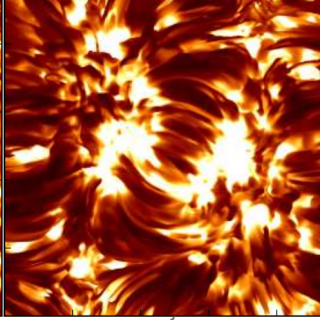Bibcode
Felipe, T.; Collados, M.; Khomenko, E.; Rajaguru, S. P.; Franz, M.; Kuckein, C.; Asensio Ramos, A.
Referencia bibliográfica
Astronomy and Astrophysics, Volume 608, id.A97, 12 pp.
Fecha de publicación:
12
2017
Revista
Número de citas
12
Número de citas referidas
11
Descripción
Aims: We investigate the properties of a sunspot light bridge,
focusing on the changes produced by the impact of a plasma blob ejected
from a C-class flare. Methods: We observed a sunspot in active
region NOAA 12544 using spectropolarimetric raster maps of the four Fe I
lines around 15 655 Å with the GREGOR Infrared Spectrograph,
narrow-band intensity images sampling the Fe I 6173 Å line with
the GREGOR Fabry-Pérot Interferometer, and intensity broad-band
images in G-band and Ca II H-band with the High-resolution Fast Imager.
All these instruments are located at the GREGOR telescope at the
Observatorio del Teide, Tenerife, Spain. The data cover the time before,
during, and after the flare event. The analysis is complemented with
Atmospheric Imaging Assembly and Helioseismic and Magnetic Imager data
from the Solar Dynamics Observatory. The physical parameters of the
atmosphere at differents heights were inferred using spectral-line
inversion techniques. Results: We identify photospheric and
chromospheric brightenings, heating events, and changes in the Stokes
profiles associated with the flare eruption and the subsequent arrival
of the plasma blob to the light bridge, after traveling along an active
region loop. Conclusions: The measurements suggest that these
phenomena are the result of reconnection events driven by the
interaction of the plasma blob with the magnetic field topology of the
light bridge.
Movies attached to Figs. 1 and 3 are available at http://www.aanda.org
Proyectos relacionados

Magnestismo Solar y Estelar
Los campos magnéticos son uno de los ingredientes fundamentales en la formación de estrellas y su evolución. En el nacimiento de una estrella, los campos magnéticos llegan a frenar su rotación durante el colapso de la nube molecular, y en el fin de la vida de una estrella, el magnetismo puede ser clave en la forma en la que se pierden las capas
Tobías
Felipe García

Magnetismo, Polarización y Transferencia Radiativa en Astrofísica
Los campos magnéticos están presentes en todos los plasmas astrofísicos y controlan la mayor parte de la variabilidad que se observa en el Universo a escalas temporales intermedias. Se encuentran en estrellas, a lo largo de todo el diagrama de Hertzsprung-Russell, en galaxias, e incluso quizás en el medio intergaláctico. La polarización de la luz
Ernest
Alsina Ballester